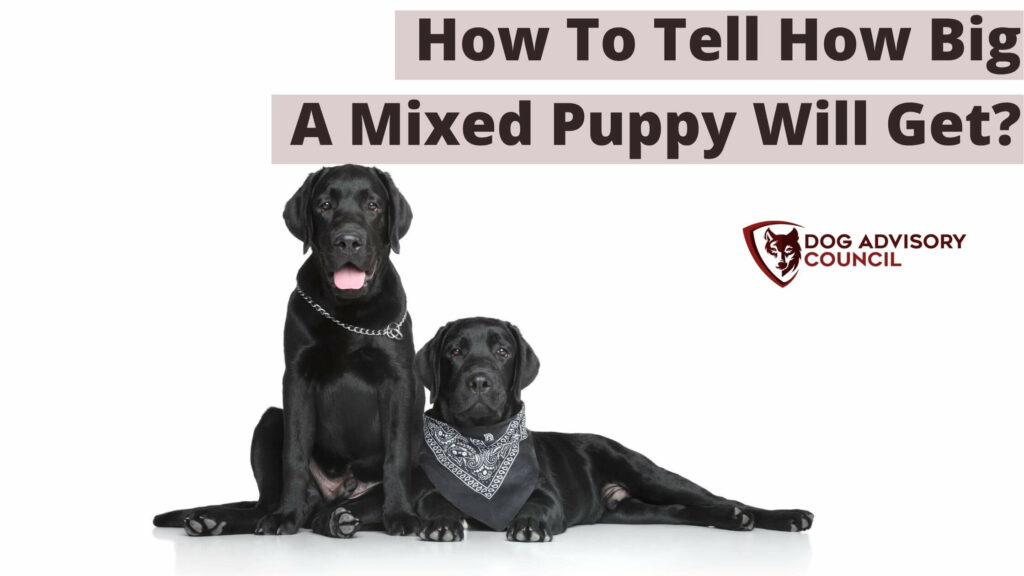
Figuring out the size of your mixed breed puppy can be a bit of a guessing game. Or is there a way to tell for sure? Find out below how to tell how big a mixed puppy will get!
There are several ways to see how large your mixed breed puppy will be. The first and most accurate way is to look at your pup’s parents. Most will be between their heights, and many tend to take on their mother’s dimension more than their father’s.
Another way uses math. At 14 weeks of age, take their weight and multiply it by 2.5. This number will tell you what their adult/full-sized weight will be. If you’ve got a large dog, use 2 instead of 2.5. You can also use less specific ways, such as determining their adult size by their bone structure, paw size, and coat length!
How can I estimate what size my mixed puppy will be?
As we introduced above, there are several ways that will give you varying levels of success in determining your mixed breed puppy size. Let’s look at them all in greater detail:
- Assessing the parents’ sizes
- Mathematical figuring
- Assessing bone structure/muscle tone
- Estimating by paw size
- Estimating by coat length
Assessing the parents’ sizes
The best indicator for understanding size is looking at the dimensions and size of both parents. Since it’s mixed breeds, you never entirely know what parent your puppy will take after. However, the size of both parents will give you an approximate size range that you can reasonably expect your puppy to be.
While this is not a guarantee (more on that later), it will give you a great range of just what you can expect from your mixed-breed puppy.
Mathematical figuring
For those that want something a bit more specific — especially for those that are number lovers — you can do some math! For small and medium-sized dogs, you’ll weigh them at 14 weeks of age and then multiply that weight by 2.5. Those with large dogs take their weight at 16 weeks of age and multiply it by 2.
The number that you get (for both) will predict their final weight when they reach adulthood. This will correlate to height!
Assessing bone structure/muscle tone
The next thing you can use to help you get a sense of size is assessing bone structure and muscle tone. When dogs are smaller, they need thinner bones and less muscle. Large dogs need heavier and denser bones and more muscle. If your puppy has large bones and thick musculature building, it’s a good indicator that they’ll be pretty large!
Estimating by paw size
Much the same as above, the paw size of your dog is also going to tell you just how big your dog can get! After all, a large dog can’t survive with tiny paws, right? So, puppies with abnormally large paws will grow into large dogs, too! When they appear to have “grown into their paws,” this is a good sign that they are almost done with their growth.
Estimating by coat length
This marker isn’t quite as specific as the other methods, but it is an excellent option to help you be more aware of things. If their coat is longer, they tend to be larger, denser dog breeds. If their coat is shorter, they’ll often be smaller dogs. This isn’t always a hard and fast rule, though, so don’t use this as your only size marker!
Other ways to determine how big a mixed puppy will get
There are a few other ways you can determine how large your puppy will get if you want a second opinion or even more data to use in your assessment! These include:
- Asking a friend with the same type of dog
- Asking your vet
- Asking a breeder
- Take a look at blogs and online dog-related forums
Dog size categories
So, what are your actual categories for your dog? There are 4 main options out there, which are small, medium, large, and giant.
Small size breeds
These dogs often weigh less than 20 lbs (9 kg) and reach their full size somewhere between 9-12 months of age.
Medium-sized breeds
Dogs in this category often will be between 20-60 lbs (9-27 kg) and will enjoy about 12-15 months before reaching their full adult size.
Large-sized dog breeds
Many dogs in this category will grow to be 60-120 lbs (27-54 kg), which is quite a range, as you can see. This increase in size also means that their growth range will require longer. Often, 15-18 months of growth.
Giant size breeds
These are, of course, the largest dogs out there. These extra large dogs can weigh 120 lbs (kg) and often will go well beyond that! This kind of size means that they’ll need 18 months of growth to reach their full size.
Can a puppy grow bigger than their parents?
As mentioned above, you can get a feel for a dog’s size by getting it through what their parents’ dimensions are. However, sometimes a mixed-breed puppy can grow larger than their parents! This is especially likely in male mixed puppies since they will be larger than females.
When it comes to a mixed breed puppy, there’s no such thing as a “sure thing,” which is why you need to be aware of the size parameters as guidelines rather than absolutes. May pet parents bring mixed breed es back to their breeders because they are the wrong size. It’s a heartbreaking reality that has nothing to do with the dog.
The other thing is that some may not know their puppy’s parents. That is, a litter of puppies can each have a different father. Or, your mixed breed puppy (more commonly known as the vulgar term “mutt”) could be “new to you,” and you may not know much about their breeding.

Does the male or female dog determine the size of the puppies?
Typically puppy size tends to match the gender match of the parent. However, some experts say that the female dog is objectively the one that determines the size since she’s the one that carries them and makes room for them in her stomach!
What age do puppies grow the most?
Most puppies will grow the most during their first 6 months of age. Often, these stages have “awkward” phases. For example, long legs and huge paws. These first 6 months of growth will help even out some of those characteristics, though they won’t all resolve until your puppy has reached adulthood for size, etc.
Puppy growth stages
There are several stages in growth for your puppy. These all come with different time frames and expectancies. The 5 stages you want to know about before adulthood are below!
The neonatal stage
This is the first 2 weeks of their life. During this stage, they can’t hear or see. They mostly move around only to nurse on their mother. This healthy nursing is required for a healthy start to their life.
Transitional stage
Between 2-4 weeks of age, puppies transition from neonates to actual puppies. Their eyes open, and they start to walk and play and look just as puppies should look.
Socialization stage
In this stage, puppies are between 4-6 weeks old. In this important stage of life, they must be exposed to as many things as possible to be brave, sociable, and happy puppies. If this socialization window isn’t taken seriously, puppies can be aggressive and anxious, making it much harder on pet parents.
As far as development goes, this stage is the most important one for both growth and social expectations!
Ranking stage
Puppies are now between 3-6 months old. This stage is when they start to understand ranking or social order. This is an excellent time to start training them, as they’ll understand that you are in charge of them and it’ll help them to understand their own place, too.
Adolescence
When puppies reach their teenage years, it can stretch from 6 months to 15 months. They are considered adults at that point. This point in their life is focused on learning their place in the family, including their ranking and role with children, adults, and other pets. They’ll develop a strong bond with their humans and other family members.
What are some tips for dealing with a mixed puppy’s size?
If you are dealing with a mixed-breed puppy whose size isn’t what you’d like to see, you might need some help. Here are some details that can help you get to the bottom of the size issue:
- Do your research on both parent breeds
- Understand the size as a non-changeable thing
- Adjust your expectations
- Be a responsible pet parent
Do your research on both parent breeds
Research is your best friend when you realize your puppy is getting much bigger or you notice it’s much smaller than you thought it would be. It will help you to know more about what each parent breed considers normal, which will lead you to understand more about what to expect with your puppy.
While doing this research before you bring your puppy home is ideal, you can always do it after the fact too!
Understand the size as a non-changeable thing
Your puppy’s size is not something that you can negotiate or change. If you are feeling unsettled about something to do with your puppy’s size, don’t blame your breeder or your vet or, of course, your puppy. Accept that it’s a part of life, and you have to accept it as it is.
Adjust your expectations
When you see what your puppy is turning out to be, size-wise, you’ll need to adjust your expectations so that you can simply “meet your puppy where they are.” Your puppy is still the sweet ball of fur you’ve always known and loved; their size is just slightly off. Adjust your expectations for their look and size, and everything will be fine.
Be a responsible pet parent
This is important! Even if your puppy’s size is annoying and you’re frustrated with dealing with a dog who’s now a different size than you had expected, you should remember that they are not responsible for this cause! Don’t bring your dog back to the breeder or abandon them just because they’re “not the right size” when you researched them with your breeder.
All in all
Your mixed breed puppy should be ween their parents regarding their overall dimensions, so you can use that to guide you in understanding their adult size.
You can also predict their size by taking their weight at 14 or 16 months of age and multiplying it by 2.5 or 2. This will give you an estimate of their adult weight, and you can get their height from that. Less specific ways include measuring paw size, bone density, and coat length!
If you know a pet parent who wants to have more than one way to predict their puppy’s mature size, consider sharing this with them!
